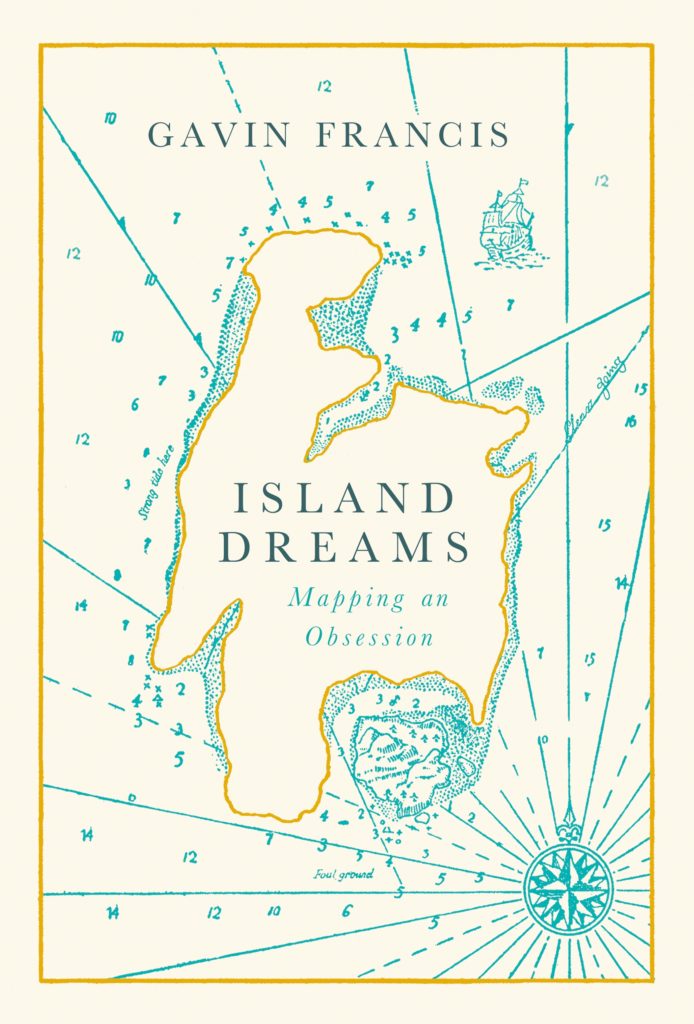In Island Dreams: Mapping an Obsession, recently published by Canongate, Gavin Francis sheds new light on the importance of islands and isolation in our collective consciousness. Read an extract from the book below.

Through my own childhood and adolescence, family holidays were often to campsites on the Fife coast, where the estuary of the River Forth relaxes into the expansiveness of the North Sea. The Lothian side of the shore, where I now live, was visible on clear days along the southern horizon. This Fife coast was once home to Alexander Selkirk, a tanner’s son born in 1676, who became a navigator and privateer – a kind of state-sponsored pirate – and in 1704 was marooned on an island in the South Pacific. Rescue came after four years and four months. His story inspired Daniel Defoe to write the tale of Robinson Crusoe.
My brother and I slept on camp beds in a caravan’s curtainless awning – as I waited for sleep I’d count the firefly scintillation of lighthouses on the shorelines opposite. The nearest was the light on the Isle of May, part-way across the firth, which issued two white flashes every fifteen seconds.
One of the earliest lighthouses in northern Europe still stands on the May. It was a simple coal brazier atop a stone-built tower, first kindled in 1636. Selkirk would have sailed past it on his way to the high seas, and on his eventual return. I hoped one day to reach it.
As a boy I had a bowdlerised edition of The Swiss Family Robinson. The tale, written originally in German, is of a family shipwrecked on their way to Australia, forced to make an island life together, adopting Robinson Crusoe as a guide. The author was heavily influenced by the educational ideas of Rousseau. At the close of the family’s decade of isolation some members opted for a return to civilisation, while others stayed on in what, to my mind, seemed a paradise. As it still does.
Shiant Isles
At age twenty-one the writer Adam Nicolson inherited the Shiant Isles, a tiny archipelago between the Scottish mainland and the Hebridean island of Lewis. In his book about them, Sea Room, he wrote: Perhaps…the love of islands is a symptom of immaturity, a turning away from the complexities of the real world to a much simpler place, where choices are obvious and rewards straightforward. And perhaps that can be taken another step: is the whole Romantic episode, from Rousseau to Lawrence, a vastly enlarged and egotistical adolescence?
My work as a physician requires immersion in the complexities of human relationships. Few jobs are better suited to someone interested in what motivates and inspires human beings, and what connects them.
But through adolescence, medical school, and working as a doctor in speciality training, it began to dawn on me that I sought out islands to recalibrate my sense of what matters. Their absence of connection, their isolation, was therapeutic in a way I found difficult to articulate.
Treasure Island
When I first saw Muckle Flugga, like the albatross I too thought it looked like home. A lighthouse built in the nineteenth century by the famous Stevenson family clings limpet-like to its highest ridge. It is lapped on the west by the Atlantic, and on the east by the North Sea. During its construction it was visited by a son of the family, the young Robert Louis Stevenson (the lighthouse was completed in 1858), and a legend exists that his map of Treasure Island is based on the outline of Unst.
In my home town of Edinburgh I often pass the headquarters of the Northern Lighthouse Board, announced at eye level on a neat Georgian street by a polished brass plaque. The board’s insignia is a white minaret of a lighthouse on a background of Iznik blue, towering over a shallow bowl of white-topped Hokusai waves. The waves are saw-like, breaking over a serration of black rocks so neatly that it’s difficult, at first, to tell where the waves end and where the foundations of the lighthouse begin. Like Virginia Woolf’s, it is a stark tower on a bare rock.
In Salutem Omnium –‘for the safety of all’ – is written in letters of gold on a banner draped around the tower’s lantern house. Like a pilot who sleeps best by a runway, I sleep easiest within sight of the sea.
*
‘Island Dreams‘ is out now, and available to order from your local independent book shop.